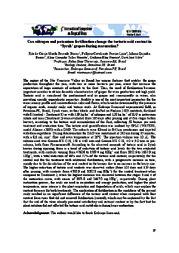Can nitrogen and potassium fertilization change the tartaric acid content in 'Syrah' grapes during maturation?
Can nitrogen and potassium fertilization change the tartaric acid content in 'Syrah' grapes during maturation?
Author(s): NASSUR, R. de C. M. R.; LIMA, P. C. P.; BARROS, J. Q.; BIASOTO, A. C. T.; PEREIRA, G. E.; SILVA, D. J.
Summary: The region of the São Francisco Valley in Brazil has unique features that enables the grape production throughout the year, with two or more harvests per year, event that increase the exportation of large amounts of nutrients to the fruit. Thus, the need of fertilization becomes important in order to obtain desirable characteristics of grapes for wine production and high yield. Tartaric acid is considered the predominant acid in grapes and consequently in wines, also providing specific organoleptic properties.
Publication year: 2016
Types of publication: Abstract in annals or event proceedings
Unit: Embrapa Grape & Wine
Keywords: Adubação, Maturação da uva, Potássio, Uva, Uva Syrah, Vale do São Francisco
Observation
Some of Embrapa's publications are published as ePub files. To read them, use or download one of the following free software options to your computer or mobile device. Android: Google Play Books; IOS: iBooks; Windows and Linux: Calibre.
Access other publications
Access the Agricultural Research Database (BDPA) to consult Embrapa's full library collection and records.
Visit Embrapa Bookstore to purchase books and other publications sold by Embrapa.

